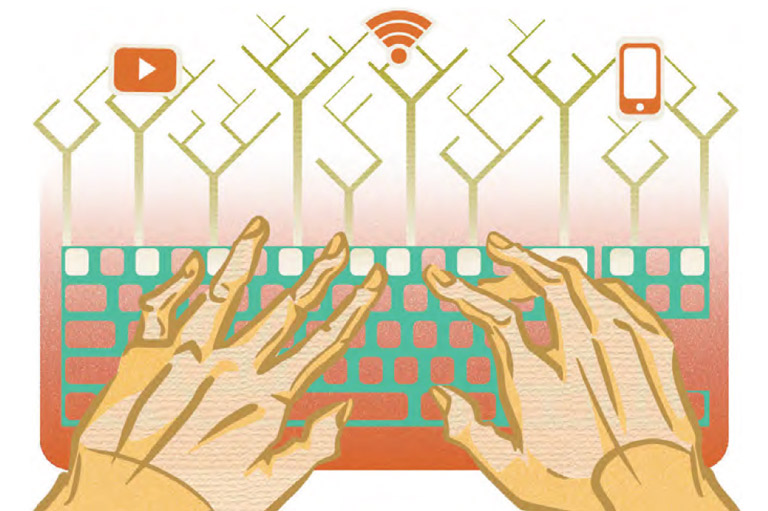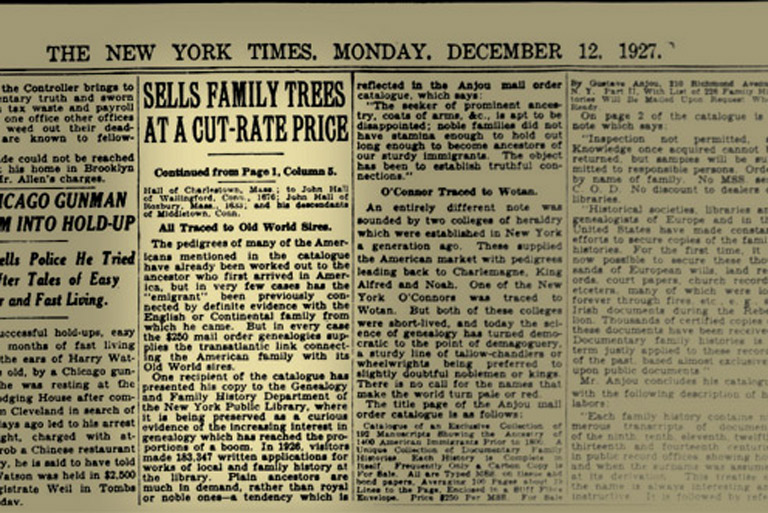Roots: Can You Relate?
What proportion of your genetic makeup is Neanderthal in origin? Are you descended from royalty? How recently do you share common ancestry with a Mongolian herder? These are just a few of the questions the new generation of mathematical geneticists, archaeogeneticists, and paleoanthropologists can now answer.

In Meet Your Marker, we saw how advances in the incidence and technology of DNA testing have resolved formerly hopeless family history problems. Without getting into genetic theory, we covered the three main types of analysis:
- paternal-line testing, involving comparison of Y-chromosome DNA transmitted only from father to son;
- maternal-line testing of mitochondrial DNA, which each of us inherits only from our mothers; and
- statistical kinship prediction, properly known as “autosomal testing,” requiring analysis of hundreds of thousands of DNA markers across the twenty-two non-sex chromosomes each of us carries (i.e., not including the X and Y chromosomes that determine sex).
Most family historians focus on ancestors who lived within the past couple of hundred years. In unique cases where the documentary record is good, such as the recent confirmation of the discovery in England of Richard III’s skeleton, we may be able to apply DNA findings several hundred years earlier. Yet the same tests, when used in conjunction with the archaeological record and mathematical analysis, can yield information across vastly greater time scales, insights into our so-called “deep ancestry” or ancient genetic origins.
Perhaps the best-known work in this field is The Seven Daughters of Eve, published in 2001 by British geneticist Bryan Sykes. He elaborated on mitochondrial DNA discoveries, since fine-tuned, that suggest those of European descent can trace their matrilineal origins to one of seven genetically distinct women. Scholars further argue that all of humanity ultimately descends from a single matrilineal “Eve.”
Useful as such terminology is in selling books and publicizing the field, it almost inevitably misleads the layperson. In fact, one respected blogger goes so far as to label it a “de facto deception.” At the very least it abets self-deception as we mistakenly extend the intended scope of the Biblical analogy and jump to the erroneous conclusion that Mitochondrial Eve is the only female ancestor common to all mankind. In fact, researchers believe we share many female ancestors through myriad genetic pathways, quite apart from strict descent on the maternal line.
Consider your own forebears. You have four great-grandmothers, but you are descended from only one of them on the maternal line. Go back another four generations, maybe 200 to 250 years ago, a blip in genetic time, and your maternal line represents only one sixty-fourth of your female genetic heritage. Odds are high that we all descend from many women alive at the time of Mitochondrial Eve.
Advertisement
A similar, and similarly misleading, analogy can be made with “Y-chromosomal Adam,” though, disappointingly for the romantics among us, he never met Mitochondrial Eve. He is thought to have walked the earth no more than 140,000 years ago, possibly more recently; she existed at least 50,000 years earlier.
A focus on these unique lines of descent misleads us in a subtler way by shifting our perception of the era in which we can claim shared ancestry. Mathematical geneticists calculate that our most recent common ancestor (MRCA) lived within the past several thousand years! Yes, you’re reading that correctly. It is estimated that 99.99999 per cent of contemporary humans, including you, me, and the Mongolian herder, descend from a single individual who lived within the past five to seven thousand years, possibly even in the Common Era (or AD, as some of us still think of it). The only exceptions: possibly a few hundred individuals in isolated societies with zero contact with the outside world throughout this entire period.
Our MRCA lived side by side with people whose genetic line subsequently petered out and others who have many descendants living today, so we shouldn’t think of the MRCA as a solitary individual or as an unusually prolific genetic provider. We all have many ancestors who were the MRCA’s contemporaries, and there is no guarantee than any one of us still carries any of the MRCA’s genetic material after all this time. Each of us descends from the MRCA through different lines and possibly via different sexual partners. As people die and are born, the MRCA may in fact change. In short, it is the concept of the MRCA that is striking rather than anything inherently special about the individual.
If we push back a little further in time, we reach a moment when every human then living was the ancestor either of no one or of everyone alive today. This identical ancestors point (IAP) is estimated to have occurred five to fifteen thousand years ago.
Why the surprisingly recent estimates for the MRCA and IAP? The answer lies in the phenomenon of pedigree collapse. In our classic understanding of a pedigree, an individual has two parents, four grandparents, and so on, with every successive generation twice as large. Common sense tells us that this exponential growth can’t go on indefinitely. Pedigree collapse is the mathematical explanation for the commonsense reality that you can’t have more ancestors than there were people at the time. Inevitably, and frequently in any pedigree, cousins of some degree marry one another and whenever they do, the overlapping segments of their ancestries are duplicated in their progeny’s pedigrees. For much of human history, marriages between second or third cousins were the norm. The upshot is that you don’t have to go too far back within any population to find that everyone who had descendants is an ancestor, often many times over.
Pedigree collapse explains why we can all claim, with absolute confidence, to be descended from royalty. Everyone of European descent, it is calculated, can count Charlemagne as an ancestor — and quite a few other monarchs before and since.
It’s not just mathematical geneticists who are driving the revolution in learning about deep ancestry. Paleoanthropologists and archaeogeneticists are proving increasingly adept at extracting DNA from ancient human remains and comparing it with modern reference samples.
As an example, it now seems likely that Eurasians derive between one and four per cent of their DNA from Neanderthals. DNA evidence also suggests genetic admixtures between other archaic humans and different populations around the world. At least two major DNA-testing organizations now routinely assess the Neanderthal contribution to the genetic samples they analyze.
Archaeologically retrieved DNA can also give us quite specific information about ancient population dynamics. As a case in point, it has long been debated whether the Otomi people, conquered by the Aztecs in the late fourteenth century, fled from or continued to live in the city state of Xaltocan. Mitochondrial DNA analysis compared human remains antedating and postdating the conquest and concluded that the populations were genetically different — the female populations, at any rate. We can expect scores of comparable findings around the globe in years to come as the history, and pre-history, books are rewritten.
Analysis of the DNA of contemporary indigenous peoples is similarly a burgeoning field, most notably the National Geographic Society’s Genographic Project. You too can participate (US $199.95, plus shipping) and can expect to discover “the migration paths your ancient ancestors followed hundreds — even thousands — of years ago,” as well as to learn “what percentage of your genome is affiliated with specific regions of the world” or with Neanderthal ancestry.
It’s a slow week when there isn’t at least one new research study that challenges our perception of which human populations moved where and when and interacted with whom. As I write, one recent study argues for a “gene flow” between India and Australia about 4,200 years ago.
Another posits that the Roma people left northwest India within the past 850 years and enjoyed a rapid expansion of their population once they reached Europe. All of this may be as nothing compared with what we can soon expect. The mapping of your complete genome, unavailable at any price a decade ago, now costs just six thousand dollars, less than some of us paid for our first plasma TVs. Another ten years and it could be $995 at Future Shop. You’re worth it. You are, after all, royalty. I think I detect a tiara. No, sorry, it’s a brow ridge.
Themes associated with this article
Advertisement
You might also like...

Canada’s History Archive, featuring The Beaver, is now available for your browsing and searching pleasure!









